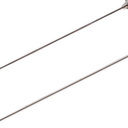Hepatitis C virus (HCV) in cryoglobulinaemic leukocytoclastic vasculitis (LCV): could the presence of HCV in skin lesions be related to T CD8+ lymphocytes, HLA-DR and ICAM-1 expression?
Keywords
Abstract
An association between mixed cryoglobulinaemia (MC) and hepatotropic viruses, chiefly hepatitis C virus (HCV), has been widely reported. The presence of HCV genomic sequences or HCV-related viral proteins in the serum, purified cryoglobulins, peripheral blood mononuclear cells and into several tissues has suggested an important triggering role for HCV in MC patients. However, only few reports investigated the presence of HCV in cutaneous vasculitis and its potential pathogenetic role. Biopsies of cutaneous purpuric lesions from 5 MC female patients (aged from 40 to 80 years) were carried out for virological and histopathological evaluation. A leukocytoclastic vasculitis pattern was found in 4/5 subjects, while the presence of HCV RNA was detected in 3/5. In only 3 cases biopsy specimens were sufficient for immunohistochemical and direct immunofluorescence (DIF) studies. Immunohistochemical evaluation was performed by means of alkaline phosphatase and monoclonal anti-alkaline phosphatase (APAAP) immune-complexes. In the same skin specimen APAAP and DIF findings were compared with the presence/absence of HCV genomic sequences (PCR technique). In 1 MC patient, the detection of HCV-RNA was associated to a prevalent CD8+ T suppressor pattern with a perivascular and subjunctional distribution as well as an intense expression of second class (HLA-DR) and intercellular adhesion (ICAM-1) molecules on basal keratinocytes, endothelial cells and perivascular infiltrate. These findings suggest a marked inflammatory activation that spreads from endothelial cells to keratinocytes and Langerhans cells. In the 2 HCV-RNA negative specimens the scanty immunopathological staining could indicate a residual activity due to the previous inflammatory event triggered by cryoglobulins. The deposition of circulating HCV-containing immune complexes (CIC) in the skin could be the initial pathogenic event for cryoglobulinemic vasculitis; subsequently CIC could spread from the vascular bed to the perivascular tissue and then could be very rapidly eliminated. If confirmed in larger patients' series these findings could definitely demonstrate a direct role of HCV in the pathogenesis of cryoglobulinemic vasculitis.



